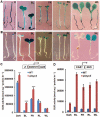The regulation of the Z- and G-box containing promoters by light signaling components, SPA1 and MYC2, in Arabidopsis
- PMID: 23646119
- PMCID: PMC3639979
- DOI: 10.1371/journal.pone.0062194
The regulation of the Z- and G-box containing promoters by light signaling components, SPA1 and MYC2, in Arabidopsis
Abstract
Although many transcription factors and regulatory proteins have been identified and functionally characterized in light signaling pathways, photoperception to transcription remains largely fragmented. The Z-box is one of the LREs (Light responsive elements) that plays important role in the regulation of transcription during light-controlled Arabidopsis seedling development. The involvement of photoreceptors in the modulation of the activity of the Z-box containing promoters has been demonstrated. However, the role of downstream signaling components such as SPA1 and MYC2/ZBF1, which are functionally interrelated, remains unknown. In this study, we have investigated the regulation of the Z-box containing synthetic and native promoters by SPA1 and MYC2 by using stable transgenic lines. Our studies suggest that SPA1 negatively regulates the expression of CAB1 native promoter. MYC2 negatively regulates the activity of Z- and/or G-box containing synthetic as well as native promoters irrespective of light quality. Moreover, MYC2 negatively regulates the expression of Z/G-NOS101-GUS even in the darkness. Furthermore, analyses of tissue specific expression in adult plants suggest that MYC2 strongly regulates the activity of Z- and G-box containing promoters specifically in leaves and stems. In roots, whereas MYC2 positively regulates the activity of the Z-box containing synthetic promoter, it does not seem to control the activity of the G-box containing promoters. Taken together, these results provide insights into SPA1- and MYC2-mediated transcriptional regulation of the Z- and G-box containing promoters in light signaling pathways.
Conflict of interest statement
Figures







Similar articles
-
Functional interconnection of MYC2 and SPA1 in the photomorphogenic seedling development of Arabidopsis.Plant Physiol. 2010 Nov;154(3):1210-9. doi: 10.1104/pp.110.163717. Epub 2010 Sep 23. Plant Physiol. 2010. PMID: 20864543 Free PMC article.
-
MYC2 differentially regulates GATA-box containing promoters during seedling development in Arabidopsis.Plant Signal Behav. 2013 Oct;8(10):doi: 10.4161/psb.25679. doi: 10.4161/psb.25679. Plant Signal Behav. 2013. PMID: 23857363 Free PMC article.
-
Functional interrelation of MYC2 and HY5 plays an important role in Arabidopsis seedling development.Plant J. 2019 Sep;99(6):1080-1097. doi: 10.1111/tpj.14381. Epub 2019 Jun 24. Plant J. 2019. PMID: 31059179
-
Z-box binding transcription factors (ZBFs): a new class of transcription factors in Arabidopsis seedling development.Mol Plant. 2013 Nov;6(6):1758-68. doi: 10.1093/mp/sst140. Epub 2013 Oct 24. Mol Plant. 2013. PMID: 24157607 Review.
-
MYC2: A Master Switch for Plant Physiological Processes and Specialized Metabolite Synthesis.Int J Mol Sci. 2023 Feb 9;24(4):3511. doi: 10.3390/ijms24043511. Int J Mol Sci. 2023. PMID: 36834921 Free PMC article. Review.
Cited by
-
Exploration of the Effect of Blue Light on Functional Metabolite Accumulation in Longan Embryonic Calli via RNA Sequencing.Int J Mol Sci. 2019 Jan 21;20(2):441. doi: 10.3390/ijms20020441. Int J Mol Sci. 2019. PMID: 30669555 Free PMC article.
-
Citrullus colocynthis NAC transcription factors CcNAC1 and CcNAC2 are involved in light and auxin signaling.Plant Cell Rep. 2014 Oct;33(10):1673-86. doi: 10.1007/s00299-014-1646-z. Epub 2014 Jun 28. Plant Cell Rep. 2014. PMID: 24972826
-
A mitogen-activated protein kinase cascade module, MKK3-MPK6 and MYC2, is involved in blue light-mediated seedling development in Arabidopsis.Plant Cell. 2014 Aug;26(8):3343-57. doi: 10.1105/tpc.114.128702. Epub 2014 Aug 19. Plant Cell. 2014. PMID: 25139007 Free PMC article.
-
Identification and molecular evolution of the GLX genes in 21 plant species: a focus on the Gossypium hirsutum.BMC Genomics. 2023 Aug 22;24(1):474. doi: 10.1186/s12864-023-09524-w. BMC Genomics. 2023. PMID: 37608304 Free PMC article.
-
Genome-wide identification of the AAAP gene family and expression analysis under tissue-specific expression in five legumes.BMC Genomics. 2025 Feb 21;26(1):173. doi: 10.1186/s12864-025-11224-6. BMC Genomics. 2025. PMID: 39984851 Free PMC article.
References
Publication types
MeSH terms
Substances
LinkOut - more resources
Full Text Sources
Other Literature Sources
Molecular Biology Databases

